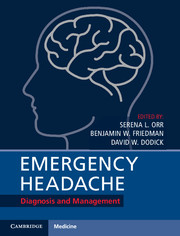Book contents
- Emergency Headache
- Emergency Headache
- Copyright page
- Contents
- Contributors
- Preface
- 1 Introduction
- 2 Epidemiology of Headache in the Emergency Department
- 3 Approach to History Taking and the Physical Examination
- 4 Approach to Investigations
- 5 Thunderclap Headache in the Emergency Department
- 6 Other Secondary Headaches in the Emergency Department
- 7 The Migraine Patient in the Emergency Department
- 8 The Patient with a Trigeminal Autonomic Cephalalgia in the Emergency Department
- 9 Other Primary Headache Disorders That Can Present to the Emergency Department
- 10 Medication Overuse Headache in the Emergency Department
- 11 Approach to the Pediatric Patient with Headache in the Emergency Department
- 12 Approach to Pregnant or Lactating Patients with Headache in the Emergency Department
- 13 Approach to the Elderly Patient with Headache in the Emergency Department
- 14 Preventing Emergency Department Visits in Primary Headache Patients and Prevention of Bounce-Backs to the Emergency Department
- Index
- References
7 - The Migraine Patient in the Emergency Department
Published online by Cambridge University Press: 09 October 2017
- Emergency Headache
- Emergency Headache
- Copyright page
- Contents
- Contributors
- Preface
- 1 Introduction
- 2 Epidemiology of Headache in the Emergency Department
- 3 Approach to History Taking and the Physical Examination
- 4 Approach to Investigations
- 5 Thunderclap Headache in the Emergency Department
- 6 Other Secondary Headaches in the Emergency Department
- 7 The Migraine Patient in the Emergency Department
- 8 The Patient with a Trigeminal Autonomic Cephalalgia in the Emergency Department
- 9 Other Primary Headache Disorders That Can Present to the Emergency Department
- 10 Medication Overuse Headache in the Emergency Department
- 11 Approach to the Pediatric Patient with Headache in the Emergency Department
- 12 Approach to Pregnant or Lactating Patients with Headache in the Emergency Department
- 13 Approach to the Elderly Patient with Headache in the Emergency Department
- 14 Preventing Emergency Department Visits in Primary Headache Patients and Prevention of Bounce-Backs to the Emergency Department
- Index
- References
Summary
Migraine is the most common primary headache disorder seen in the emergency department (ED). Patients with migraine present to the ED for a variety of reasons, including intolerable pain severity, failure of at-home treatment strategies, and debilitating associated symptoms. The diagnosis and management of migraine in the ED can be challenging. In this chapter, the epidemiology of migraine in the ED will be reviewed. A detailed and practical approach to the diagnosis and management of migraine in the ED will be outlined, followed by a discussion of discharge planning issues in this population.
- Type
- Chapter
- Information
- Emergency HeadacheDiagnosis and Management, pp. 65 - 79Publisher: Cambridge University PressPrint publication year: 2017

